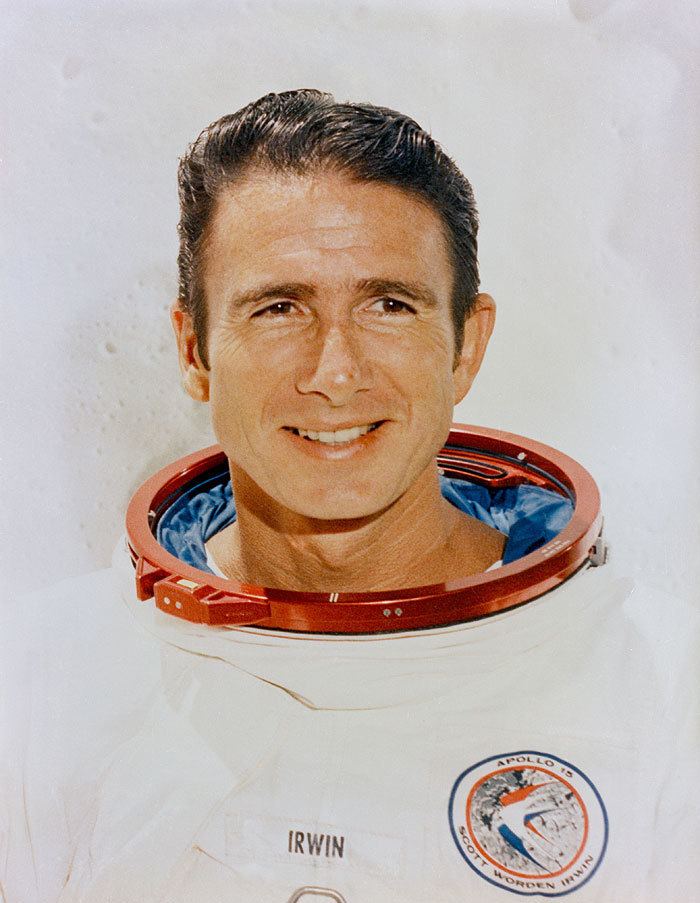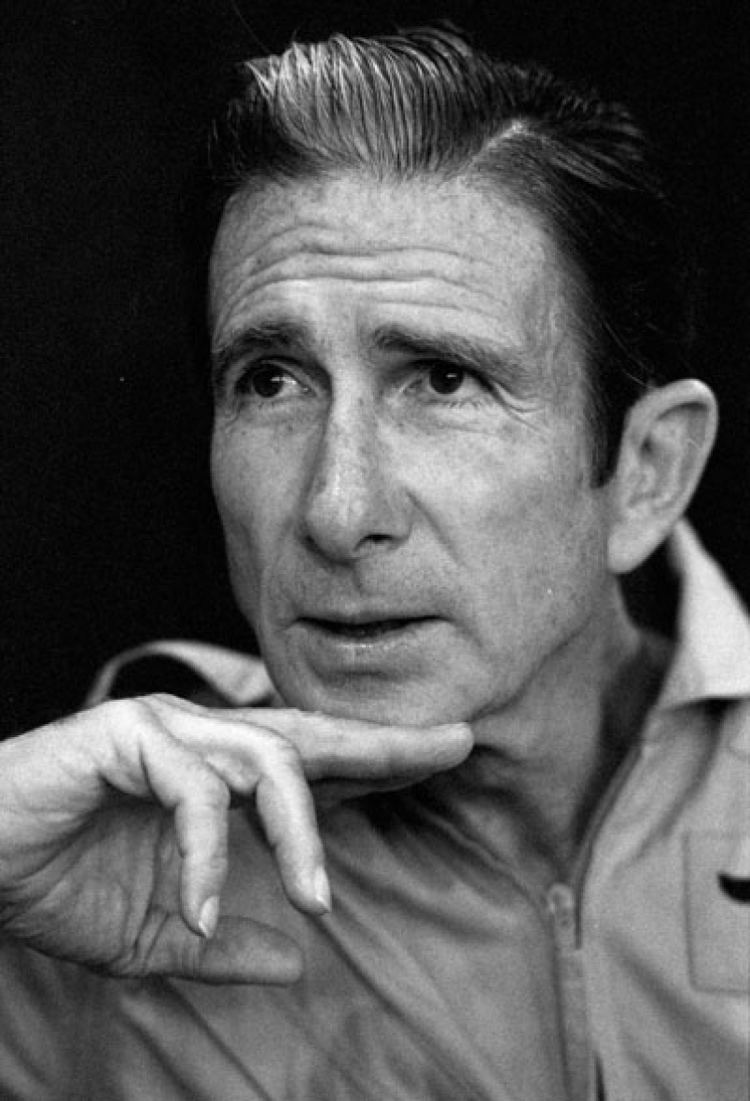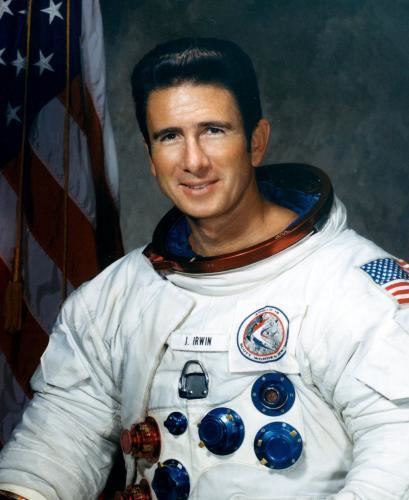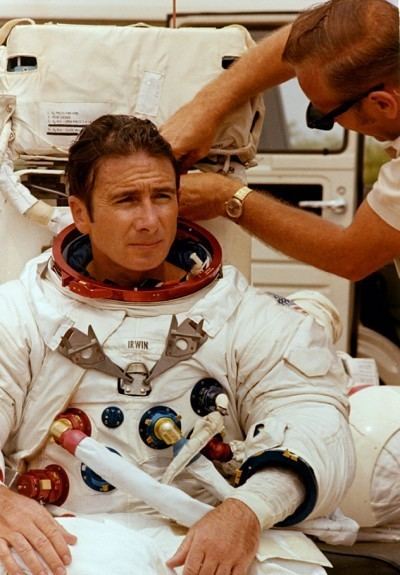Nationality American Time in space 12d 07h 12m | Role Astronaut Status Deceased Name James Irwin | |
 | ||
Born James Benson IrwinMarch 17, 1930Pittsburgh, Pennsylvania, U.S. ( 1930-03-17 ) Alma mater USNA, B.S. 1951UMich, M.S. 1957 Books More Than Earthlings, The It's Just Lunch Guide to Dating in Pittsburgh Similar People David Scott, Alfred Worden, Arthur W Radford | ||
James Irwin
James Benson "Jim" Irwin (March 17, 1930 – August 8, 1991) (Col, USAF) was an American astronaut, aeronautical engineer, test pilot, and a United States Air Force pilot. He served as lunar module pilot for Apollo 15, the fourth human lunar landing. He was the eighth person to walk on the Moon and the first, and youngest, of those astronauts to die.
Contents
- James Irwin
- Nasa apollo 15 james irwin climbing the lm ladder
- Early life and education
- NASA career
- Apollo 15
- Post NASA career
- Death
- Organizations
- Awards and honors
- In media
- References

Nasa apollo 15 james irwin climbing the lm ladder
Early life and education
Irwin was born March 17, 1930, in Pittsburgh, Pennsylvania of Scottish and Irish descent, to parents James Irwin (1896–1979) and Elsa Mathilda Irwin (née Strebel; 1899–1993). Irwin's grandparents emigrated to the U.S. from Altmore Parish at Pomeroy in County Tyrone, Ireland (now Northern Ireland) around 1859. He graduated from East High School in Salt Lake City, Utah in 1947. He received a Bachelor of Science degree in Naval Science from the United States Naval Academy in 1951, and a Master of Science degree in Aeronautical Engineering and Instrumentation Engineering from the University of Michigan in 1957.

He received initial flight training at Hondo Air Base and follow-on training at Reese Air Force Base, Texas. He graduated from the Air Force Experimental Test Pilot School (Class 60C) in 1961, and the Aerospace Research Pilot School in 1963 (Class IV). Prior to joining NASA, he was chief of the Advanced Requirements Branch at Headquarters Air Defense Command. During his time in the United States Air Force he received the Air Force Distinguished Service Medal and two Air Force Commendation Medals. He also received an Air Force Outstanding Unit Citation while with the 4750th Training Wing.

Irwin was also a developmental test pilot for the Lockheed YF-12, the Mach 3 fighter-interceptor variant which preceded the SR-71 Blackbird. His first flight of that aircraft was on the day that one of his five children was born.

In 1961, a student pilot that Irwin was training crashed the plane they were flying on a training mission. They both survived, but Irwin suffered compound fractures, amnesia, and nearly lost a leg. Dr. John Forrest, a U.S. Air Force orthopedic surgeon, was instrumental in preventing the amputation of Irwin's leg.

During his military service, he accumulated more than 7,015 hours flying time, of which 5,300 hours were in jet aircraft.
NASA career
Irwin was one of the 19 astronauts selected by NASA in April 1966. He was chosen as Commander, with John S. Bull as Lunar Module Pilot, for LTA-8, an environmental qualification test of the Apollo Lunar Module in a vacuum chamber at the Houston Space Environment Simulation Laboratory. He then served as a member of the astronaut support crew for Apollo 10, the first mission to carry the full Apollo stack to the Moon and the dry run for the first manned Moon landing. Following that assignment, Irwin served as backup Lunar Module Pilot for the second Moon landing mission, Apollo 12.
Apollo 15
Between July 26 and August 7, 1971 – as the Apollo 15 Lunar Module Pilot (LMP) – Irwin logged 295 hours and 11 minutes in space. His extravehicular activity (EVA) on the Moon's surface amounted to 18 hours and 35 minutes of the mission time (an additional 33 minutes was used to do a stand-up EVA by opening the LM's docking hatch to survey the surroundings and take photographs). Irwin and David Scott's mission was more science-based than previous missions, which meant that they received intensive geological training to meet the demanding nature of the J-Mission profile. This extra training is credited with allowing them to make one of the most important discoveries of the Apollo era, the Genesis Rock.
Apollo 15 landed in the Moon's Hadley-Apennine region, noted for its mountains and rilles. As a J-Mission, they would spend more time on the moon than previous missions, to allow for three EVAs. As well, Irwin was the first automobile passenger on the Moon as Scott drove the Lunar Roving Vehicle (LRV) carried along for this mission in the Lunar Module (LM) Falcon's Descent Stage. Scott and Irwin's stay on the Moon was just under three days at 66 hours and 54 minutes.
Once the rendezvous procedure was completed between Falcon and the Endeavour CSM, Irwin and Scott were busy moving items like rock samples into the CSM and preparing the Lunar Module for final separation. During this intense period of work the earliest symptoms of a heart condition appeared. Both Scott and Irwin had been working with no sleep for 23 hours, during which they conducted a final moonwalk, performed the ascent from the lunar surface, rendezvoused with Endeavour, and encountered the problems that delayed the Lunar Module jettison maneuver. The astronauts' physiological vital signs were being monitored back on Earth, and the flight surgeons noticed some irregularities in Irwin's heart rhythms. Irwin's heart had developed bigeminy. Dr. Charles Berry stated to Chris Kraft, deputy director of the Manned Spacecraft Center (MSC) at the time: "It's serious, [i]f he were on Earth. I'd have him in ICU being treated for a heart attack." However, Berry concluded that since Endeavour's cabin atmosphere was 100% oxygen when in space, Irwin was in the best of circumstances. Specifically, "In truth,...he's in an ICU. He's getting one hundred percent oxygen, he's being continuously monitored, and best of all, he's in zero g. Whatever strain his heart is under, well, we can't do better than zero g."
During the post-Trans-Earth injection (TEI) phase of the mission there wasn't much more for Irwin to do other than provide help with Al Worden's EVA to retrieve film magazines from the CSM's SIM bay, by donning a pressure suit and monitoring him. He was able to rest and apparently recover during the rest of the mission. The flight surgeons continued to monitor his EKG until splashdown, but his heart rhythm was normal. This incident apparently was not discussed during the mission debriefing sessions, and the condition did not appear when he returned to Earth.
Post-NASA career
After the return of Apollo 15 to Earth, it was discovered that, without authority, the crew had taken 398 commemorative first day covers to the moon of which a hundred were then sold to a German stamp dealer. The profits of the sale were intended to be used to establish trust funds for the Apollo 15 crew's children. NASA had turned a blind eye to similar activities on earlier flights, but on this occasion the administration reprimanded the astronauts, and they never got any funds from the sales. Irwin had announced his intent to retire from the Air Force and resign from NASA prior to the reprimand.
After his retirement as a Colonel in 1972, Irwin founded the High Flight Foundation. He spent the next 20 years as a "Goodwill Ambassador for the Prince of Peace", stating that "Jesus walking on the earth is more important than man walking on the moon". He frequently spoke about how his experiences in space had made God more real to him than before.
Beginning in 1973, Irwin led several expeditions to Mount Ararat, Turkey, in search of the remains of Noah's Ark. In 1982, he was injured during the descent and had to be transported down the mountain on horseback. In More Than Earthlings, Irwin wrote expressing his view that the Genesis creation narrative was real, literal history.
Death
Irwin suffered at least three serious heart attacks. One occurred less than two years after Apollo 15, when Irwin was 43, while he was playing handball. Irwin suffered another heart attack in 1986, when he collapsed during a run and was found pulseless on a curb. Physicians from NASA doubted the incidents were related to space travel, and noted that pre-flight testing indicated a tendency for cardiac arrhythmias during strenuous exercise.
On August 8, 1991, Irwin suffered another heart attack after a bike ride earlier that day. Attempts at resuscitation were unsuccessful, and Irwin died later that day in the hospital. He was buried at Arlington National Cemetery. He was survived by his widow, Mary Ellen, and their five children.
Of the 12 men who have walked on the moon, Irwin was the first to die. The James Irwin Charter Schools were founded in Colorado in his honor.
A patch cut by Irwin from a backpack abandoned on the Moon during the Apollo 15 mission was auctioned at Christie's in 2001 for US$310,500 in a consignment of material from Irwin's estate that garnered "a combined $500,000".
Organizations
Irwin was a member of the Air Force Association and the Society of Experimental Test Pilots.
Awards and honors
Irwin's other awards include: Belgium's Order of Leopold in 1971; Kitty Hawk Memorial Award, 1971; New York Police Department St. George Association's Golden Rule Award in 1972; Christian Service Award; Milan Hulbert Trophy of SWAP International in 1973.
He was also awarded an Honorary Doctorate of Astronautical Engineering from the University of Michigan in 1971; an Honorary Doctorate of Science from the William Jewell College in 1971; and an Honorary D.Sc. from the Samford University in 1972.
He was inducted into the International Space Hall of Fame in 1983, and the U.S. Astronaut Hall of Fame, on October 4, 1997. In 1973, When Irvin visited the city of Minden, Louisiana, to address a gathering at the First Baptise Church, Mayor Tom Colten declared "James Irwin Day" and made Irwin an "honorary citizen of Minden."
In media
In the 1998 HBO miniseries From the Earth to the Moon Irwin was played by Gareth Williams.
